Royal Canadian Mounted Police
The Royal Canadian Mounted Police (RCMP; French: Gendarmerie royale du Canada (GRC), lit. 'Royal Gendarmerie of Canada'; colloquially known as the "Mounties", and internally as the "Force") is the federal and national police service of Canada, providing law enforcement at the federal level. The RCMP also provides provincial policing in eight of Canada's provinces (all except Ontario and Quebec) and local policing on a contract basis in the three territories (Northwest Territories, Nunavut, and Yukon) and more than 150 municipalities, 600 Indigenous communities, and three international airports. The RCMP does not provide active provincial or municipal policing in Ontario or Quebec.[10] However, all members of the RCMP have jurisdiction as a peace officer in all parts of Canada, including Ontario and Quebec.[11] Despite the name, the Royal Canadian Mounted Police is no longer an actual mounted police force, with horses only being used at ceremonial events.
| Royal Canadian Mounted Police Gendarmerie royale du Canada (French) | |
|---|---|
Logo of the RCMP | |
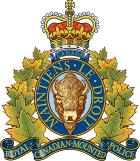 | |
 Corps ensign[2] | |
| Abbreviation | RCMP/GRC |
| Motto | Maintiens le droit (French for "maintain the right" or "uphold the law")[3] |
| Agency overview | |
| Formed | 1 February 1920[4] |
| Preceding agencies |
|
| Employees | 30,092 (2019) |
| Volunteers | Approximately 1,600 Auxiliary Constables[5] |
| Jurisdictional structure | |
| Operations jurisdiction | Canada |
| Constituting instruments |
|
| General nature | |
| Operational structure | |
| Headquarters | M. J. Nadon Government of Canada Building 73 Leikin Drive Ottawa, Ontario K1A 0R2[6] |
| Sworn members | 18,986[7] (Apr. 2019)
|
| Unsworn members | 11,210[7] (Apr. 2019)
|
| Elected officer responsible |
|
| Agency executives |
|
| Parent agency | Public Safety Canada |
| Divisions | 15[7]
|
| Facilities | |
| Detachments | 712[8]
|
| Vehicles | 8,677
|
| Boats | 5 |
| Fixed-wings | 26[9] |
| Helicopters | 8[9] |
| Notables | |
| Significant incidents | |
| Awards | |
| Website | |
| rcmp-grc | |
| While a federal agency, the RCMP also serves as the local law enforcement agency for various provincial, municipal, and First Nations jurisdictions.[10] | |
As Canada's national police force, the RCMP is primarily responsible for enforcing federal laws throughout Canada, whereas general law and order including the enforcement of the criminal code and applicable provincial legislation is constitutionally the responsibility of the provinces and territories. Larger cities may form their own municipal police departments.
The two most populous provinces, Ontario and Quebec, maintain provincial forces: the Ontario Provincial Police and Sûreté du Québec. The other eight provinces contract policing responsibilities to the RCMP. The RCMP provides front-line policing in those provinces under the direction of the provincial governments. When Newfoundland joined the confederation in 1949, the RCMP entered the province and absorbed the then-Newfoundland Ranger Force, which patrolled most of Newfoundland's rural areas. The Royal Newfoundland Constabulary patrols urban areas of the province. In the territories, the RCMP is the sole territorial police force. Many municipalities throughout Canada contract to the RCMP. Thus, the RCMP polices at the federal, provincial, and municipal level. In several areas of Canada, it is the only police force.
The RCMP is responsible for an unusually large breadth of duties. Under their federal mandate, the RCMP police throughout Canada, including Ontario and Quebec (albeit on smaller scales there). Federal operations include: enforcing federal laws including commercial crime, counterfeiting, drug trafficking, border integrity, organized crime, and other related matters; providing counter-terrorism and domestic security; providing protection services for the Canadian Monarch, governor general, prime minister, their families and residences, and other ministers of the Crown, visiting dignitaries, and diplomatic missions; and participating in various international policing efforts.
Under provincial and municipal contracts the RCMP provides front-line policing in all areas outside of Ontario and Quebec that do not have an established local police force. There are detachments located in small villages in the far north, remote First Nations reserves, and rural towns, but also larger cities such as Surrey, British Columbia (population 468,251). There, support units investigate for their own detachments, and smaller municipal police forces. Investigations include major crimes, homicides, forensic identification, collision forensics, police dogs, emergency response teams, explosives disposal, and undercover operations. Under its National Police Services branch the RCMP supports all police forces in Canada via the Canadian Police Information Centre, Criminal Intelligence Service Canada, Forensic Science and Identification Services, Canadian Firearms Program, and the Canadian Police College.
The RCMP Security Service was a specialized political intelligence and counterintelligence branch with national security responsibilities, replaced by the Canadian Security Intelligence Service in 1984, following revelations of illegal covert operations relating to the Quebec separatist movement.[12] CSIS is not part of the RCMP, but is its own entity.
History
Founding
.jpg)
Prime Minister Sir John A. Macdonald first began planning a permanent force to patrol the North-West Territories after the Dominion of Canada purchased the territory from the Hudson's Bay Company. Reports from army officers surveying the territory led to the recommendation that a mounted force of between 100 to 150 mounted riflemen could maintain law and order. The Prime Minister first announced the force as the "North West Mounted Rifles". However, officials in the United States raised concerns that an armed force along the border was a prelude to a military buildup. Macdonald then renamed the force the North-West Mounted Police (NWMP) when formed in 1873.[13]
The force added "royal" to its name in 1904. It merged with the Dominion Police, the main police force for all points east of Manitoba, in 1920 and was renamed the "Royal Canadian Mounted Police". The new organization was charged with federal law enforcement in all the provinces and territories, and immediately established its modern role as protector of Canadian national security, as well as assuming responsibility for national counterintelligence.
As part of its national security and intelligence functions, the RCMP infiltrated ethnic or political groups considered to be dangerous to Canada. This included the Communist Party of Canada, but also a variety of minority cultural and nationalist groups. The force was also deeply involved in immigration matters, and especially deportations of suspected radicals. They were especially concerned with Ukrainian groups, both nationalist and socialist.[14] The Chinese community was also targeted because of disproportionate links to opium dens. Historians estimate fully two percent of the Chinese community was deported between 1923 and 1932, largely under the provisions of the Opium and Narcotics Drugs Act (ONDA).[15] Besides the RCMP's new responsibilities in intelligence, drugs enforcement, and immigration, the force also assisted numerous other federal agencies with tasks such as enforcing attendance of Indigenous children at schools within the Canadian Indian residential school system schools, designed to assimilate them into the dominant Canadian culture.
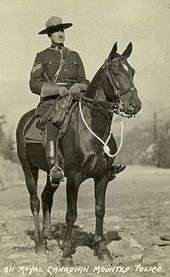
In 1935, the RCMP, collaborating with the Regina Police Service, crushed the On-to-Ottawa Trek by sparking the Regina Riot, in which one city police officer and one protester were killed. The Trek, which had been organized to call attention to the abysmal conditions in relief camps, therefore failed to reach Ottawa, but nevertheless had profound political reverberations. The RCMP also lost four officers in Saskatchewan and Alberta that year in what became the 1935 Royal Canadian Mounted Police Killings.
The RCMP employed special constables to assist with strikebreaking in the interwar period. For a brief period in the late 1930s, a volunteer militia group, the Legion of Frontiersmen, were affiliated with the RCMP. Many members of the RCMP belonged to this organization, which was prepared to serve as an auxiliary force. In later years, special constables performed duties such as policing airports and, in some Canadian provinces, the courthouses.
In 1932 saw the men, vehicles and vessels of the Customs Preventive Service, National Revenue, absorbed by the RCMP. This created the Marine Section and the Excise Section.[16] The acquisition of the RCMP schooner St. Roch facilitated the first effective patrol of Canada's Arctic territory. It was the first vessel to navigate the Northwest Passage from west to east (1940–42), the first to navigate the passage in one season (from Halifax to Vancouver in 1944), the first to sail either way through the passage in one season, and the first to circumnavigate North America (1950).[17]
Counterintelligence work was moved from the RCMP's Criminal Investigation Department to a specialized intelligence branch, the RCMP Security Service, in 1939.
Post-war
On April 1, 1949, Newfoundland joined in full confederation with Canada and the Newfoundland Ranger Force amalgamated with the RCMP.
Following the 1945 defection of Soviet cipher clerk, Igor Gouzenko, and his revelations of espionage, the RCMP Security Service implemented measures to screen out "subversive" elements from the public sector.[18]
In June 1953, the RCMP became a full member of the International Criminal Police Organisation (Interpol).[19]
Queen Elizabeth II approved in Regina, Saskatchewan, on July 4, 1973, a new badge for the RCMP, in recognition of which the force presented the sovereign with a tapestry rendering of the new design.[20]
In the late 1970s, revelations surfaced that the RCMP Security Service force had in the course of their intelligence duties engaged in crimes such as burning a barn and stealing documents from the separatist Parti Québécois, and other abuses. This led to the Royal Commission of Inquiry into Certain Activities of the RCMP, better known as the "McDonald Commission", named for the presiding judge, Justice David Cargill McDonald. The commission recommended that the force's intelligence duties be removed in favour of the creation of a separate intelligence agency, the Canadian Security Intelligence Service (CSIS). The RCMP and CSIS nonetheless continue to share responsibility for some law enforcement activities in the contemporary era, particularly in the anti-terrorism context.[21]
Modern era
_Sunset_Ceremony_2012.jpg)
In 1993, the Special Emergency Response Team (SERT), were transferred to the Canadian Forces (CF), creating a new unit called Joint Task Force 2 (JTF2). JTF2 inherited some equipment and SERT's former training base near Ottawa.
In 2006, the United States Coast Guard's Ninth District and the RCMP began a program called "Shiprider", in which 12 Mounties from the RCMP detachment at Windsor and 16 US Coast Guard boarding officers from stations in Michigan ride in each other's vessels. The intent is to allow for seamless enforcement of the international border.[22]
On December 6, 2006, RCMP Commissioner Giuliano Zaccardelli resigned after admitting that his earlier testimony about the Maher Arar terrorist case was inaccurate. The RCMP's actions were scrutinized by the Commission of Inquiry into the Actions of Canadian Officials in Relation to Maher Arar. In the aftermath of the Arar affair, the Commission of Inquiry recommended that the RCMP be subject to greater oversight from a review board with investigative and information-sharing capacities.[23] Following the Commission of Inquiry's recommendations, the Harper government tabled amendments to the RCMP Act to create the Civilian Review and Complaints Commission.[23]
Two officers were found guilty of perjury and sentenced to jail for their actions in the 2007 Robert Dziekański Taser incident in Vancouver.
In 2007, the RCMP was named Newsmaker of the Year by The Canadian Press.[24]
On June 3, 2013, the RCMP renamed its 'A' Division to National Division and tasked it with handling corruption cases "at home and abroad".[25]
The RCMP also has an aviation security division, the Sky Marshals.[26]
Notable cases
- The American stagecoach robber Bill Miner was captured by the RCMP in 1906.[27]
- Albert Johnson, known as the Mad Trapper of Rat River, was killed in a shoot-out with the RCMP in 1932.[27]
- RCMP officers in Saskatchewan arrested the perpetrator of the Shell Lake murders in 1967.
- Anarchist militants known as the Squamish Five were arrested by the RCMP in 1983.
- The suspected driver of the reconnaissance vehicle involved in the 1996 Khobar Towers bombing fled to Canada where he was arrested by the RCMP in the winter of 1997 and was extradited to the United States.
- Four RCMP officers were fatally shot during an operation in Alberta in March 2005: the Mayerthorpe tragedy was the single worst multiple killing of RCMP officers since the killing of 3 officers in Kamloops British Columbia by a mentally ill assailant in June 1962. Prior to that the Force had not felt such a loss since the North-West Rebellion.[28]
- In July 2007, two RCMP officers were shot dead in the Spiritwood Incident near Mildred, Saskatchewan.
- Three RCMP officers were murdered during the Moncton shooting in New Brunswick in June 2014.[29]
- The perpetrator of the 2014 shootings at Parliament Hill, Ottawa was shot and killed at the scene by the RCMP.
- RCMP Constable Heidi Stevenson was killed while responding to a mass shooting that left over 20 people dead in Nova Scotia in April 2020.
History of the RCMP uniform
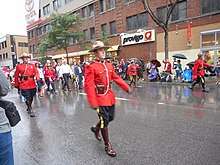
The RCMP are famous for their distinctive dress uniform, or "review order", popularly known as the "Red Serge." It has a high collared scarlet tunic, midnight blue breeches with yellow leg stripe, Sam Browne belt with white sidearm lanyard, oxblood riding boots (possibly with spurs), brown felt campaign hat (wide, flat brimmed) with the characteristic "Montana crease", and brown gloves (with brown leather gauntlets for riders). Members wear the review order during the Musical Ride, an equestrian drill in which mounted members show their riding skills and handling of the cavalry lance. On normal duties, the RCMP uses standard police methods, equipment, and uniforms. The RCMP uses horses for ceremonial operations such as escorting the governor general's open landau to the opening of Parliament.
Tunic
The Red Serge tunic that identified the NWMP and later the RNWMP and RCMP, is the standard British military pattern. In the original version, worn from 1873 to 1876, it was based on the civilian Norfolk jacket.[30] [31] Originally kitted from militia stores, the NWMP later adopted a standard style that emphasized the force's British heritage and differentiated it from the blue American military uniforms. In 1904, dark blue shoulder straps and collars replaced the uniform's scarlet facings[32] when King Edward VII granted the Force "Royal" status for its service in the Second Boer War. Today, RCMP personnel under the rank of inspector wear blue "gorget" patches on the collar, while officers from inspector to commissioner wear solid blue collars and blue pointed-sleeve cuffs.
Members once wore a white haversack on top of this jacket and white gauntlets,[31] which contrasted with the red tunic. The modern dress uniform replaces these easily dirtied items with brown leather riding gloves and carrying pouches on the belt.
Hat
Although the NWMP contingent at Queen Victoria's Diamond Jubilee wore the campaign hat, it only became official in 1904.
A campaign hat is a broad-brimmed felt or straw hat, with a high crown, pinched symmetrically at the four corners (Montana crown).
The hat is most commonly worn as part of a uniform by such agencies as the Royal Canadian Mounted Police, the New Zealand Army, United States Park Rangers, and Scouts. The RCMP did not adopt it until about 1904. The original primary summer headdress was the white British foreign service helmet, also known as a pith helmet. This was an impractical choice for the Canadian west, and RCMP members wore a Stetson type hat on patrol and around camp. Sam Steele is often credited with introducing the Stetson-type hat, and when he left the force to command Lord Strathcona's Horse in South Africa, his unit adopted the Stetson. During winter, members wore a Canadian military fur wedge cap or busby. In British Columbia, the hat features a black bearskin rim belt.
Breeches
The NWMP wore buff or steel grey breeches until they adopted dark blue breeches with yellow-gold strapping (stripes) in 1876.[33] Members often exchanged kit with U.S. cavalry units, and while some believe this was the source for the breeches, the NWMP considered adopting blue breeches with a white strap. Dark blue with yellow-gold strapping is a British cavalry tradition, and most cavalry (later armoured) regiments' dress uniforms feature yellow stripes.
Boots
Black riding boots changed to the modern brown style called "Strathcona boots" or informally as "high browns" and the original crossbelts changed to the brown Sam Browne type. The brown colour of the boots and belt the RCMP wear with the Red Serge are from members who applied coats of polish, often during training at Depot Division.
Spurs
The RCMP's original spurs, known as "long shank spurs," were solid nickel. Their owners occasionally had their regimental number engraved on the inside, and some replaced the rowel with a US buffalo nickel to complement the Mounted Police capbadge and avoid using a Canadian coin that would deface the monarch. The RCMP last issued long shank spurs in 1968.
Sidearms are standard now, but were often not worn in the early years.
Operational uniform

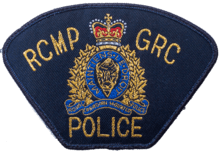
The operational uniform is a grey shirt, dark blue trousers with gold stripping, regular patrol boots called "ankle boots", regular duty equipment, and a regular policeman's style cap. Members on operational duty wear a blue Gore-Tex open-collar jacket (patrol jacket), while sergeants major and certain non-commissioned officers (NCOs) involved in recruit training or media relations wear a dark blue jacket (blue serge). Depending on their duties, officers wear white shirts and the patrol jacket or blue serge. During the summer, officers wear a short-sleeved shirt. Winter dress is a long-sleeved shirt. A tie is worn on occasion for events such as testifying in court. In colder weather, members may wear heavier boots, winter coats (storm coats) and a fur cap or toque.
In 1990, Baltej Singh Dhillon became the RCMP's first Sikh officer to be allowed to wear a turban instead of the traditional Stetson.[34] On March 15, the federal government, despite protests, decided they would allow Sikhs to wear their religious headgear while on duty as RCMP officers, as had been the practice for Sikh members of Canadian Forces for decades.
Despite ongoing pressure from groups such as the Association for the Protection of Fur-Bearing Animals,[35] the RCMP uses muskrat fur in their winter dress uniform. The RCMP originally decided not to use fur, but the government overruled them.
Decorations
The RCMP awards its Royal Canadian Mounted Police Long Service Medal to members who have completed 20 years' service. A clasp is awarded for each successive 5 years to 40 years. Members also receive a service badge star for each five years' service, which is worn on the left sleeve. There are specialist insignia for positions such as first aid instructor and dog handler, and pilot's wings are worn by aviators. Sharpshooter badges for proficiency in pistol or rifle shooting are each awarded in two grades.[36]
Women in the RCMP
In the 1920s, Saskatchewan provincial pathologist Frances Gertrude McGill began providing forensic assistance to the RCMP in their investigations.[37] She helped establish the first RCMP forensic laboratory in 1937,[38] and later served as its director for several years. In addition to her forensic work, McGill also provided training to new RCMP and police recruits in forensic detection methods.[37] Upon her retirement in 1946, McGill was appointed honorary surgeon to the RCMP, and continued to act as a dedicated consultant for the force up until her death in 1959.[39]
On May 23, 1974, RCMP Commissioner Maurice Nadon announced that the RCMP would accept applications from women as regular members of the force. Troop 17 was the first group of 32 women at Depot in Regina on September 18 and 19, 1974 for regular training. This first all-female troop graduated from Depot on March 3, 1975.

After initially wearing different uniforms, female officers were finally issued the standard RCMP uniforms. Now all officers are identically attired, with two exceptions. The ceremonial dress uniform, or "walking-out order", for female members has a long, blue skirt and higher-heeled slip-on pumps plus small black clutch purse (however, in 2012 the RCMP began to allow women to wear trousers and boots with all their formal uniforms.[40]) The second exception is the official maternity uniform for pregnant female officers assigned to administrative duties.
The following years saw the first women attain certain positions.
- 1981: corporal, musical ride
- 1987: foreign post
- 1990: detachment commander
- 1992: commissioned officer
- 1998: assistant commissioner
- 2000: deputy commissioner
- 2006: interim commissioner*
- 2018: permanent commissioner*
*Beverley Busson was the first woman to have held the top position in the force, albeit on an interim basis. She served as the interim commissioner from December 15, 2006, to July 6, 2007.[41][42] The first female commissioner Brenda Lucki was appointed on March 9, 2018, and was officially sworn into office on April 16, 2018.[43]
Military status
| Royal Canadian Mounted Police Gendarmerie royale du Canada | |
|---|---|
Guidon of the RCMP | |
| Active | 1873–present |
| Country | Canada |
| Type | Dragoons |
| Size | 15 divisions |
| Garrison/HQ | RHQ—Ottawa |
| Nickname(s) | The "Mounties" |
| Motto(s) | Maintiens le droit (Defending the law, Maintain the right)[44][45][3] |
| Battle honours | see Battle honours |
| Commanders | |
| Commissioner | Brenda Lucki |
| Commissioner-in-chief | The Queen |
| Honorary commissioner | The Prince of Wales[46] |
| Honorary deputy commissioner | The Earl of Wessex[47] |
| Insignia | |
| Tartan | RCMP |
| Abbreviation | RCMP/GRC |
Although the RCMP is a civilian police force, in 1921, following the service of many of its members during the First World War, King George V awarded the force the status of a regiment of dragoons, entitling it to display the battle honours it had been awarded.
Service in wartime
During the Second Boer War, members of the North-West Mounted Police were given leaves of absence to join the 2nd Battalion, Canadian Mounted Rifles (CMR) and Strathcona's Horse. The force raised the Canadian Mounted Rifles, mostly from NWMP members, for service in South Africa. For the CMR's distinguished service there, King Edward VII honoured the NWMP by changing the name to the "Royal Northwest Mounted Police" (RNWMP) on June 24, 1904.
During the First World War, the Royal Northwest Mounted Police (RNWMP) conducted border patrols, surveillance of enemy aliens, and enforcement of national security regulations within Canada. However, RNWMP officers also served overseas. On August 6, 1914, a squadron of volunteers from the RNWMP was formed to serve with the Canadian Light Horse in France. In 1918, two more squadrons were raised, A Squadron for service in France and Flanders and B Squadron for service in the Canadian Siberian Expeditionary Force.
In September 1939, at the outset of the Second World War, the Canadian Army had no military police. Five days after war was declared the Royal Canadian Mounted Police received permission to form a provost company of force volunteers. It was designated "No. 1 Provost Company (RCMP)", and became the Canadian Provost Corps. Six months after war was declared its members were overseas in Europe and served throughout the Second World War as military police.
Honours
The Royal Canadian Mounted Police were accorded the status of a regiment of dragoons in 1921. As a cavalry regiment, the RCMP was entitled to wear battle honours for its war service as well as carry a guidon, with its first guidon presented in 1935.[48][49] The RCMP mounted the King's Life Guard at Horse Guards Parade in 1937 leading up to the coronation of King George VI. The RCMP mounted the Queen's Life Guard in May 2012 during celebrations of Queen Elizabeth II's Diamond Jubilee.[50]
Battle honours
- North West Canada 1885
- South Africa 1900–02
- The Great War: France and Flanders 1918, Siberia 1918–19
- The Second World War: Europe, 1939–45
Honorary distinction:
- The badge of the Canadian Provost Corps (Military Police), presented September 21, 1957, at a Parliament Hill ceremony for contributions to the Corps during the Second World War
Legacy
In 1975, the RCMP dedicated a memorial beside the Fred Light Museum in Battleford, Saskatchewan, consisting of a cemetery with gate, cairn and list of honour plaque to the members of the North-West Mounted Police (1873–1904) and the RCMP.[51]
Organization
International
The RCMP International Operations Branch (IOB) assists the Liaison Officer (LO) Program to deter international crime relating to Canadian criminal laws. The IOB is a section of the International Policing, which is part of the RCMP Federal and International Operations Directorate. Thirty-seven Liaison Officers are placed in 23 other countries and are responsible for organizing Canadian investigations in other countries, developing and maintaining the exchange of criminal intelligence, especially national security with other countries, to provide assistance in investigations that directly affect Canada, to coordinate and assist RCMP officers on foreign business and to represent the RCMP at international meetings.[52] Liaison Officers are located in:
- Africa & Middle East:
- Asia-Pacific:
- Europe:
- The Americas:
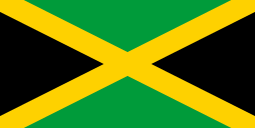





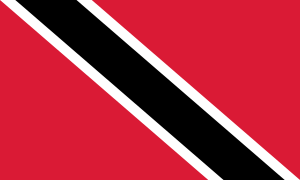

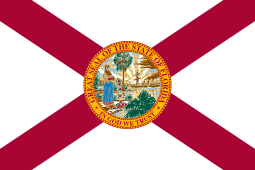
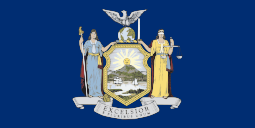


The RCMP was a member agency in the Afghan Threat Finance Cell, and RCMP officers were embedded with military units in Afghanistan.[53]
National
The RCMP is organized under the authority of the Royal Canadian Mounted Police Act (RCMP Act), an act of the Parliament of Canada. Pursuant to sections 3 and 4 of the RCMP Act, the RCMP is a police force for Canada—namely, a federal police force.[54] However, section 20 of the RCMP Act provides that the RCMP may be used for law enforcement in provinces or municipalities if certain conditions are met.[55] As explained by Justice Ivan Rand of the Supreme Court of Canada, "what is set up is a police force for the whole of Canada to be used in the enforcement of the laws of the Dominion, but at the same time available for the enforcement of law generally in such provinces as may desire to employ its services."[56]
Pursuant to section 5 of the RCMP Act,[57] the RCMP is headed by the commissioner, who, under the direction of the Minister of Public Safety and Emergency Preparedness, has the control and management of the force and all matters connected therewith. The RCMP is provided with a senior executive committee (SEC) which[58]
is the senior decision making forum established by the Commissioner for the development and approval of strategic, force-wide policies, pursuant to and consistent with the Commissioner's authority under section 5 of the RCMP Act. The role of [the] SEC is to develop, promote and communicate strategic priorities, strategic objectives, management strategies and performance management for the purpose of direction and accountability.
The commissioner is assisted by deputy commissioners in charge of:[59]
- Federal and international policing
- Specialized Policing Services
- National Police Services
- Contract and Indigenous Policing
- Human resources
- East
- Ontario ("O" Division)
- National Division (Formerly "A" Division)
- National headquarters
- Quebec ("C" Division)
- New Brunswick ("J" Division)
- Nova Scotia ("H" Division)
- Prince Edward Island ("L" Division)
- Newfoundland and Labrador ("B" Division)
- West
- British Columbia ("E" Division)
- Alberta ("K" Division)
- Saskatchewan ("F" Division)
- Manitoba ("D" Division)
- Yukon ("M" Division)
- Northwest Territories ("G" Division)
- Nunavut ("V" Division)
Divisions
The RCMP divides the country into divisions for command purposes. In general, each division is coterminous with a province (for example, C Division is Quebec). The province of Ontario, however, is divided into two divisions: National Division (Ottawa) and O Division (rest of the province). There is one additional division – Depot Division, which is the RCMP Academy at Regina, Saskatchewan, and the Police Dog Service Training Centre[60] at Innisfail, Alberta. The RCMP headquarters are located in Ottawa, Ontario.
- National Division (formerly A Division): National Capital Region (Ottawa, Ontario, and Gatineau, Quebec)[61]
- B Division: Newfoundland and Labrador[62]
- C Division: Quebec[63]
- D Division: Manitoba[63]
- E Division: British Columbia
- F Division: Saskatchewan[64]
- G Division: Northwest Territories[65]
- H Division: Nova Scotia[66]
- J Division: New Brunswick[67]
- K Division: Alberta[68]
- L Division: Prince Edward Island[69]
- M Division: Yukon[70]
- O Division: Ontario[71]
- V Division: Nunavut[72]
- Depot Division at Regina and the Police Dog Service Training Centre[60] at Innisfail.
Detachments
A detachment is a section of the RCMP which polices a local area. Detachments vary greatly in size. The largest single RCMP detachment is in the City of Surrey in British Columbia, with over a thousand employees. Surrey has contracted with the RCMP for policing services since 1951.[73] The second-largest RCMP detachment is in Burnaby, also in British Columbia.[74] Conversely, detachments in small, isolated rural communities have as few as three officers. The RCMP formerly had many single-officer detachments in these areas,[75][76] but in 2012 the RCMP announced that it was introducing a requirement that detachments should have at least three officers.[76]
Personal Protection Group
The Personal Protection Group or PPG is a 180-member group responsible for security details for VIPs, the prime minister, and the governor general.[77] It was created after the 1995 incident at 24 Sussex Drive.[78]
Units under the PPG consists of:
- Prime Minister Protective Detail provides bodyguards to protect the Prime Minister of Canada in Canada and abroad. This unit is based in Ottawa with operations at 24 Sussex Drive and Harrington Lake near Chelsea, Quebec.
- Governor General’s Protection Detail provides bodyguards to protect the Governor General of Canada in Canada and abroad. This unit is based in Ottawa with operations at Rideau Hall.
- Very Important Persons Security Section (VIPSS) provides security details to VIP (including the Chief Justice of Canada, federal ministers, and diplomats) and others under the direction of the Minister of Public Safety.
Personnel
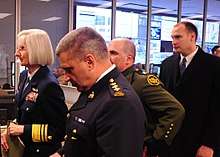
As of April 1, 2019, the RCMP employed 30,196 men and women, including police officers, civilian members, and Public Service Employees.[7]
Actual personnel strength by ranks:
- Commissioners: 1
- Deputy commissioners: 6
- Assistant commissioners: 28
- Chief superintendents: 57
- Superintendents: 187
- Inspectors: 322
- Corps sergeants major: 1
- Sergeants major: 8
- Staff sergeants major: 9
- Staff sergeants: 838
- Sergeants: 2,018
- Corporals: 3,599
- Constables: 11,913
- Special constables: 122
- Civilian members: 7,695
- Public servants: 3,403
- Total: 30,196
Regular members
The term regular member, or RM, originates from the RCMP Act and refers to the 18,988 regular RCMP officers who are trained and sworn as peace officers, and include all the ranks from constable to commissioner. They are the police officers of the RCMP and are responsible for investigating crime and have the authority to make arrests. RMs operate in over 750 detachments, including 200 municipalities and more than 600 Indigenous communities. RMs are normally assigned to general policing duties at an RCMP detachment for a minimum of three years. These duties allow them to experience a broad range of assignments and experiences, such as responding to emergency (9-1-1) calls, foot patrol, bicycle patrol, traffic enforcement, collecting evidence at crime scenes, testifying in court, apprehending criminals and plain clothes duties. Regular members also serve in over 150 different types of operational and administrative opportunities available within the RCMP, these include: major crime investigations, emergency response, forensic identification, forensic collision reconstruction, international peacekeeping, bike or marine patrol, explosives disposal and police dog services. Also included are administrative roles including human resources, corporate planning, policy analysis and public affairs.
Auxiliary constables and other staff
Besides the regular RCMP officers, several types of designations exist which give them assorted powers and responsibilities over policing issues.
Currently, there are:
- Community constables: Varies across Canada
- Reserve constables : Varies across Canada[79]
- Auxiliary constables: Varies across Canada[80]
- Special constables: 122[7]
- Civilian members: 7,590[7]
- Public servants: 3,497[7]
- Community constables (CC)
- A designation introduced in 2014 as a replacement for the community safety officers and Indigenous community constables pilot programs.[81][82] Community constables are armed, paid members holding the rank of special constables, with peace officer power.[83] They are to provide a bridge between the local citizens and the RCMP using their local and cultural knowledge[84] They are mostly focused on crime prevention, liaisons with the community, and providing resources in the event of a large-scale event.[85]
- Reserve constables (R/Cst.)
- A program reinstated in 2004 in British Columbia, it was later expanded to cover all of Canada in order to allow for retired, regular RCMP members and other provincially trained officers to provide extra manpower when shortages are identified.[86] R/Cst. are appointed under Section 11 of the Royal Canadian Mounted Police Act as paid part-time, armed officers with the same powers as regular members.[87] However, they are not allowed to carry force-issued sidearms and use of force options unless they are called upon to duty.[86] They generally carry out community policing roles but may also be called upon if an emergency occurs.[86][88]
- Auxiliary constables (A/Cst.)
- Volunteers within their own community, appointed under provincial police acts.[80] They are not police officers and can not identify themselves as such. However, they are given peace officer powers when on duty with a regular member (RM). Their duties consist mainly of assisting RMs in routine events, for example cordoning off crime scene areas, crowd control, participating in community policing, assistance during situations where regular members might be overwhelmed with their duties (e.g., keeping watch of a backseat detainee while RM interviews a victim). They are identified by the wording of "RCMP Auxiliary" on cars, jackets and shoulder flashes
- Special constables (S/Cst.)
- Employees of the RCMP have varied duties depending on where they are deployed, but are often given this designation because of an expertise they possess which needs to be applied in a certain area. For example, an Indigenous person might be appointed a special constable in order to assist regular members as they police an Indigenous community where English is not well understood, and where the special constable speaks the language well. They still perform this role today in many isolated northern communities and the RCMP has 122 special constables who are active in the RCMP today, and they are drawn almost entirely from the same Indigeous communities that they serve.
- From the early years of policing in northern Canada, and well into the 1950s, local Indigenous peoples were hired by the RCMP as special constables and were employed as guides and to obtain and care for sled dog teams. Many of these former special constables still reside in the north to this day and are still involved in regimental functions of the RCMP.
- Civilian members of the RCMP
- While not delegated the powers of police officers, they are instead hired for their specialized scientific, technological, communications and administrative skills. Since the RCMP is a multi-faceted law enforcement organization with responsibilities for federal, provincial and municipal policing duties, it offers employment opportunities for civilian members as professional partners within Canada's national police force.
Civilian members represent approximately 14% of the total RCMP employee population, and are employed within RCMP establishments in most geographical areas of Canada. The following is a list of the most common categories of employment that may be available to interested and qualified individuals.
- Operations
- Telecommunications operator (dispatcher)[89]
- Scientific
- Technical
- Forensic identification services
- Instrument technology
- Document examination
- Counterfeit analysis
- Firearms technology
- Electronics technology
- Information technology
- Communications
- Computer systems development
- Telecommunications
- Information services/public affairs
- Administrative
- Policy development and analysis
- Staff development and training
- Human resource management
- Translation
- Police Records Information Management Environment (PRIME-BC)
- Public service employees
- Also referred to as public servants, PSes or PSEs, they provide much of the administrative support for the RCMP in the form of detachment clerks and other administrative support at the headquarters level. They are not police officers, do not wear a uniform, have no police authority and are not bound by the RCMP Act.
- Municipal employees
Abbreviated as "ME" they are found in RCMP detachments where a contract exists with a municipality to provide front-line policing. MEs are not actually employees of the RCMP, but are instead employed by the local municipality to work in the RCMP detachment. They conduct the same duties that a PSE would and are required to meet the same reliability and security clearance to do so. Many detachment buildings house a combination of municipally and provincially funded detachments, and therefore there are often PSEs and MEs found working together in them.
Ranks
The rank system of the RCMP is partly a result of their origin as a paramilitary force. Upon its founding, the RCMP adopted the rank insignia of the Canadian Army (which in turn came from the British Army), which is almost identical to that of the current Canadian Army. Like in a military, the RCMP also has a distinction between commissioned and non-commissioned officers. The non-commissioned ranks are mostly based on military ranks (apart from constable). Non-commissioned officer ranks above staff sergeant resemble those that formerly existed in the Canadian Army, but have since been replaced by warrant officers.[90] The commissioned officer ranks, by contrast, use a set of non-military titles that are often used in Commonwealth police services. The number of higher ranks like chief superintendent and deputy commissioner have been added on and increased since the formation of the force, while the lower commissioned rank of sub-inspector has been dropped.
The numbers are current as of April 1, 2019:[91]
| Commissioned officers | |||||
|---|---|---|---|---|---|
| Commissioner | Deputy commissioner | Assistant commissioner | Chief superintendent | Superintendent | Inspector |
| Commissaire | Sous-commissaire | Commissaire adjoint | Surintendant principal | Surintendant | Inspecteur |
| Commr. | D/Commr. | A/Commr. | C/Supt. | Supt. | Insp. |
| 1 | 6 | 33 | 55 | 186 | 331 |
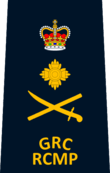 |
 |
 |
 |
 |
 |
[92] These are the official abbreviations for the commissioned and non-commissioned officers in the RCMP.[93][94]
| Non-commissioned officers | Depot | ||||||
|---|---|---|---|---|---|---|---|
| Corps sergeant major | Sergeant major | Staff sergeant major | Staff sergeant | Sergeant | Corporal | Constable | Cadet |
| Sergent-major du corps | Sergent-major | Sergent-major d'état major | Sergent d'état-major | Sergent | Caporal | Gendarme | Cadet |
| C/S/M. | S/M. | S/S/M. | S/Sgt. | Sgt. | Cpl. | Cst. | no abbreviation |
| 1 | 8 | 10 | 828 | 2,037 | 3,565 | 11,859 | Varies |
 |
 |
 |
 |
 |
 |
 |
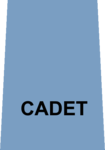 |
The ranks of inspector and higher are commissioned ranks and are appointed by the Governor-in-Council. Depending on the dress, badges are worn on the shoulder as slip-ons, on shoulder boards, or directly on the epaulettes. The lower ranks are non-commissioned officers and the insignia continues to be based on pre-1968 Canadian Army patterns. Since 1990, the non-commissioned officers' rank insignia has been embroidered on the epaulette slip-ons. Non-commissioned rank badges are worn on the right sleeve of the scarlet/blue tunic and blue jacket. The constables wear no rank insignia. There are also 122 special constables, as well as a varying number of reserve constables, auxiliary constables, and students who wear identifying insignia.
The star, or "pip", used in the insignia of commissioned officers represents the military Knight Grand Cross of the Order of the Bath. The Order's motto (tria juncta in uno, "three joined in one", referring to the holy trinity) is inscribed in a band in the middle of it. The three crowns inset in the centre not only represent the Christian Trinity, but also the three former kingdoms that became the United Kingdom. The RCMP formerly had subaltern (junior officer) ranks that were indicated by one "pip" for a sub-inspector (equivalent to an army second lieutenant) to three "pips" for an inspector (equivalent to an army captain).[95] A reorganization in 1960 changed the insignia to three "pips" for sub-inspectors[96] and a crown for inspectors,[97] making the latter a field officer rank. The rank of sub-inspector was abolished in 1990, leaving the RCMP with no subaltern ranks.
A royal crown is used in the regimental cap badge and the insignia of senior commissioned officers. In 1955 St. Edward's Crown replaced the Tudor Crown. Although Queen Elizabeth II had adopted the redesign of the heraldic crown in 1953, it took some time to design, approve, and manufacture the new insignia.
The crossed Mameluke sabre and baton is the insignia for general officers. In the RCMP it designates the commissioner (equivalent to an Army general) and their subordinate deputy commissioners (equivalent to Army lieutenant-generals). The assistant commissioners use the crown-over-three-pips insignia of an Army brigadier.
The brass shoulder title pin on the epaulettes was changed from "RCMP" to "GRC-RCMP" in 1968. (GRC stands for Gendarmerie royale du Canada, the RCMP's French-language title). This was due to a 1968 ruling stating that all statutes had to be published bilingually in both English and French. As a law enforcement agency, the RCMP had to use ranks and titles in both languages. This was later reinforced by the Official Languages Act of 1969.
Equipment and vehicles
Land fleet
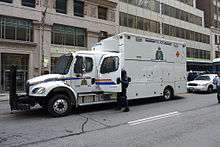
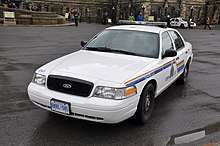
The RCMP Land Transport Fleet inventory includes:[98]
- Cars: 5,330
- Unmarked vehicles: 2,811
- Light trucks: 2,090
- Heavy trucks: 123
- SUVs: 616
- Motorcycles: 34
- Small snowmobiles: 481
- All-terrain vehicles: 181
- Gas railway cars: 1
- Tractors: 27
- Buses: 3
- Total: 11,697
Marine craft
The RCMP polices Canadian Internal Waters, including the territorial sea and contiguous zone as well as the Great Lakes and Saint Lawrence Seaway; such operations are provided by the RCMP's Federal Services Directorate and includes enforcing Canada's environment, fisheries, customs and immigration laws. In provinces and municipalities where the RCMP performs contract policing, the force polices freshwater lakes and rivers.
To meet these challenges, the RCMP operates the Marine Division, with five Robert Allan Ltd.–designed high-speed catamaran patrol vessels; Inkster and the Commissioner-class Nadon, Higgitt, Lindsay and Simmonds, based on all three coasts and manned by officers specially trained in maritime enforcement. Inkster is based in Prince Rupert, BC, Simmonds is stationed on Newfoundland's south coast, and the rest are on the Pacific Coast.[99] Simmonds sports the RCMP badge, but is otherwise painted with Canadian Coast Guard colours and the marking Coast Guard Police. The other four vessels are painted with blue and white RCMP colours.
The RCMP operates 377 smaller boats, defined as vessels less than 9.2 m (30 ft) long, at locations across Canada. This category ranges from canoes and car toppers to rigid-hulled inflatables and stable, commercially built, inboard-outboard vessels. Individual detachments often have smaller high-speed rigid-hulled inflatable boats and other purpose-built vessels for inland waters, some of which can be hauled by road to the nearest launching point.[99]
| Ship name | Type | Class | Base | Specifications | Propulsion | Top speed | Builder | Year commissioned | Crew |
|---|---|---|---|---|---|---|---|---|---|
| Inkster | Patrol vessel | n/a | Prince Rupert, BC | 19.75 m (64.8 ft) fast patrol aluminium catamaran | 25 kn (46 km/h; 29 mph)+ | Allied Shipbuilders Limited of North Vancouver, BC | 1996 | 4 | |
| Nadon | Patrol vessel | Commissioner Class PV (Raven Class) | Nanaimo, BC | 17.7 m (58 ft) fast patrol catamaran | 2 × 820 hp (610 kW) D2840 LE401 V-10 MAN diesel engines | 36 kn (67 km/h; 41 mph) | Robert Allan Ltd. | 1991 | 4 |
| Higgitt | Patrol vessel | Commissioner Class PV | Campbell River, BC | 17.7 m (58 ft) fast patrol catamaran | 2 × 820 hp (610 kW) D2840 LE401 V-10 MAN diesel engines | 36 kn (67 km/h; 41 mph) | Robert Allan Ltd. | 1992 | 4 |
| Lindsay | Patrol vessel | Commissioner Class PV | Patricia Bay, Victoria, BC | 17.7 m (58 ft) fast patrol catamaran | 2 × 820 hp (610 kW) D2840 LE401 V-10 MAN diesel engines | 36 kn (67 km/h; 41 mph) | Robert Allan Ltd. | 1993 | 4 |
| Simmonds | Patrol vessel | Commissioner Class PV | South coast Newfoundland | 17.7 m (58 ft) fast patrol catamaran | 2 × 820 hp (610 kW) D2840 LE401 V-10 MAN diesel engines | 36 kn (67 km/h; 41 mph) | Robert Allan Ltd. | 1995 | 4 |
Aircraft fleet
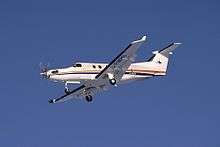
As of December 2018 the RCMP had 34 aircraft (8 helicopters and 26 fixed-wing aircraft) registered with Transport Canada (TC).[9] The new Airbus H145 is still currently registered to Airbus. All aircraft are operated and maintained by the Air Services Branch.
| Aircraft | Number[9] | Variants | Notes |
|---|---|---|---|
| Airbus H145 | 1[100] | H145 | Helicopter, light twin-engine, 4-axis autopilot.
Serving the Lower Mainland of BC ("E" Division) |
| Eurocopter AS350 Écureuil | 6 | AS 350B3 | Helicopter, AStar 350 or "Squirrel" |
| Cessna 206 | 5 | U206G, T206H | Fixed wing, Stationair (Station wagon of the Air), general aviation aircraft |
| Cessna 208 Caravan | 3 | 208, 208B | Fixed wing, Caravan, short-haul regional airliner and utility aircraft |
| de Havilland Canada DHC-6 Twin Otter | 1 | 300 Series | Fixed wing, 20-passenger STOL feederliner and utility aircraft, twin-engine. |
| Eurocopter EC120 Colibri | 2 | EC 120B | Light helicopter, "Hummingbird" |
| Pilatus PC-12 | 16 | PC-12/45, PC-12/47, PC-12/47E | Fixed wing, turboprop passenger and cargo aircraft |
| Quest Kodiak | 1 | 100 | Fixed wing, un-pressurized, turboprop-powered fixed-tricycle-gear, STOL |
Weapons and intervention options

- Smith & Wesson Model 5946 (1992–Present) - Standard full-sized service sidearm. It is stainless-steel, double-action only, with a 4-inch barrel and a double-column 15-round magazine. Emergency Response Team and dog handler members were issued a modified Model 5946 with its magazine safety removed until it was replaced by the SIG Sauer P226R.
- Smith & Wesson Model 3953 (1996–Present) - Special issue compact sidearm for plainclothes members and commissioned officers. It can also be requested as a service pistol by members with small hands who cannot positively grip the larger Model 5946. It is similar to the Model 5946 except it has a shorter 3.5-inch barrel, a shortened grip, and a single-column 8-round magazine.
- SIG Sauer 226R (9×19mm) - Standard issue sidearm for Emergency Response Team (ERT) and dog-handler members. It replaced the modified Model 5946 that had been previously issued.
- Glock Model 19 - Special issue sidearm for Canadian Air Carrier Protective Program (CACPP) members.
- Heckler & Koch MP5 - Adopted by ERT in ????
- Remington Model 700P (.308 Winchester) bolt-action rifle.
- Remington 870 12-gauge shotgun
- Colt Canada C7 rifle (5.56mm NATO)
- Colt Canada C8 carbine (5.56mm NATO) - Adopted by ERT in ????
- Colt Canada C8 IUR (Integrated Upper Receiver) 5.56mm NATO. The semi-automatic C8 IUR was adopted for general use in October, 2011.,[101] but the first batch were not procured until 2013.[102] The first RCMP Cadets began qualifying on the C8 IUR and receiving Active Shooter training in 2015.[103]
- Taser International M26, X26, & X26P. Following the Robert Dziekański Incident, all older M26 models and 60 faulty X26 models in stock were removed and destroyed in 2010 due to being outside of specifications.[104]
- Oleoresin capsicum spray
- ASP and Monadnock expandable defensive batons
Past weapons and intervention options
- Rifle
- Canadian Arsenals Limited (CAL) C1A1 - issued in 7.62mm NATO. Canadian variant of the L1A1 and FN FAL produced under licence by Canadian Arsenals Limited (CAL) (Long Branch). The RCMP's rifles were sourced from the testing batch of FALs received from Fabrique Nationale and had been rebuilt by CAL to meet C1A1 standards. Used from 1961 to 1969.
- Winchester Model 70 Issued in .308 Winchester. Used from 1960-1973. This rifle was replaced by the Remington 700.
- Lee–Enfield No. 4 Mk 1 - issued in .303 British. World War II surplus rifles used from 1947 to 1966. Replaced by CAL C1A1 and Winchester 70.
- Short Magazine Lee Enfield (SMLE) No. 1 Mk III - issued in .303 British. World War I surplus rifles used from 1919-1947.[105]
- Lee-Enfield Carbine (LEC) - issued in .303 British. Procured as military surplus from Militia stores to replace the unsatisfactory Ross Rifle. Used from 1914 to 1920. This was the last general-issue rifle used by the NWMP. The RCMP that replaced it only issued rifles according to need.
- Ross rifle - issued in .303 British. The Ross Mk I was issued from 1905 to 1907 and the improved Ross Mk II was in testing from 1909 to 1912.[105] The Mk I design was accepted by the Canadian Militia in 1903. The NWMP looked at acquiring the Ross to replace the Winchester and Lee-Metford and ordered 1000. Production problems led to delays until 1904; the most glaring being that the finished product did not match their original specifications.[105] The NWMP demanded their contract carbines use a different set of iron sight (which later became standard on the Mk II) which delayed production for a further year.[105] The carbines received in 1905 were plagued with quality control problems that made them more fragile than the weapons they were to replace. After a constable suffered an eye injury in 1907 the Ross carbines were withdrawn.[105] When the improved Ross Mk II rifles arrived in 1909 the wary NWMP decided to test fire all of them fully before issuing them. A fire at the depot in Regina in 1911 destroyed almost all of the new rifles.[105] The NWMP then gave up on the Ross.
- Magazine Lee-Enfield (MLE) Mk.I rifle - issued in .303 British; it was the first smokeless-powder weapon in NWMP service. Loaned to the NWMP from the Victoria and Winnipeg militias to replace a stolen cache of M1876 Winchesters. The NWMP "forgot" to give them back later. Used from 1902 to 1920.
- Lee-Metford Carbine - issued in .303 British. The Metford rifling gave tighter groups when fired than the later Enfield, but the rifling wore out faster. Only 200 procured. Used from 1895 to 1914. Replaced by the Lee-Enfield Carbine.
- Winchester Model 1876 saddle carbine—issued in .45-75 Winchester. Popular for its handiness and rate of fire, but it was too fragile for the rough handling and use it received in the field. Used from 1878 until 1914.[106] and replaced by the Lee-Enfield Carbine.
- Snider–Enfield Mark III Cavalry carbine - issued in .577 Snider. Single-shot breach-loading conversion of an Enfield caplock muzzle-loader. Used from 1873 to 1878 and replaced by the Winchester Model 1876 lever-action rifle.
- Service Pistol
- Smith & Wesson Military & Police revolver—issued with 5 in (130 mm) barrel, in .38 Special. It served more than forty years from 1954 to 1996. Plainclothes members carried a variant with a 4 in (100 mm) barrel.
- In 1981, the standard loading was changed from a 158 gr (0.36 oz; 10.2 g) .38 Special Full Metal Jacket (FMJ) ball round to a 158 gr (0.36 oz; 10.2 g) .38 Special +P Semi-WadCutter Hollow-Point (SWCHP), a violation of the Hague Convention of 1899 if used in a military context.[107]
- Colt New Service revolver — issued with 5.5 in (140 mm) barrel; 700 ordered in .455 Webley in 1904, with .45 Long Colt versions being delivered from 1919; in all, over 3200 issued.[107][105] 455 Webley was the British military service round and .45 Long Colt was the standard Canadian service round until both were replaced by the NATO-standard 9x19mm Parabellum post World War II. Used from 1904 to 1954.
- Enfield Mark II revolver—issued in .476 Enfield, about 1080 Mark IIs obtained from Britain's Ministry of Defence, after it was learned the Beaumont–Adams had been discontinued.[108][105] The remaining .450 Adams ammunition, which was compatible with the .476 Enfield round, was issued until stocks were depleted. Used from 1882 to 1911.
- Beaumont–Adams revolver—first issue weapon, in .450 Adams. 330 Mark Is purchased from Britain's Ministry of Defence in 1873 and issued after delivery in 1874. Rough handling of the crates in transit, poor packing by the contractor who shipped the guns, and previous service wear made them unsuitable for service.[105] The constables sometimes had to manually turn the cylinder due to cracked feed hands or keep both hands on the grips for the springs to work due to loose screws.[109] Later, these were to be replaced by 330 Enfield Mark IIs,[110] but many were stolen en route.[109] Used from 1874 to 1888.
- Pistols
Because of procurement problems with the Beaumont–Adams revolvers, constables sometimes carried their own sidearms chambered in a standard service caliber.
- Tranter revolver - chambered in .450 Adams, the standard service round. It was similar to the Beaumont-Adams revolver it was substituted for.
- Smith & Wesson Model 3 revolver - chambered in .44 Russian, a very powerful cartridge in its day. Thirty were purchased in 1874 by the NWMP to field-test the .44 Russian round for service. Its non-standard chambering and the difficulty to get ammunition for it led to its being withdrawn.
- Webley & Scott Bull Dog revolver[111] - chambered in .450 Adams. Its small size made it a handy backup pistol. Most were originally procured to arm NWMP constables assigned to protecting mail cars on trains. The constables would sometimes "absent-mindedly forget" to hand the pistols back afterwards.
- Sidearms
- 1821 pattern Light Cavalry Sabre - Originally part of a trove of old swords given by the Canadian Militia to the NWMP as weapons. They were returned to stores in 1880. Later issued to commissioned officers in 1882 as ceremonial sidearms and a sign of rank. This was later replaced by the M1896 Light Cavalry Sabre.
- 1853 pattern Cavalry Sabre - Originally part of a trove of old swords given by the Canadian Militia to the NWMP as weapons. They were returned to stores in 1880. Later issued in 1882 to non-commissioned officers as ceremonial sidearms and a sign of rank. This was later replaced by the 1821 pattern sabre.
- 1896 pattern Light Cavalry Sabre - Replaced the 1821 pattern sabre as the NWMP officer's ceremonial sword.
- 1908 pattern cavalry saber - Carried by the Mounted Police detachment sent to Siberia in 1918 during the Russian Civil War.
- Straightstick baton manufactured in wood and plastic
- Sap gloves Prohibited by RCMP Policy. Not currently used.
Ceremonial weapons and symbols of office
- 1912 pattern cavalry officer's sword carried by officers. Blade is acid etched both sides with the monarch's crown, Canadian coat of Arms, royal cypher and RCMP badge.
- 1908 pattern cavalry sword carried by NCOs on the Musical Ride
- Bamboo-shafted lance carried by members on horseback on the Musical Ride. The lance is used as a decorative item and is flourished during trick and formation riding. The pennant is red over white, the national colours of the Canadian flag. It represents the Pattern 1868 cavalry lance carried by the NWMP in the 1870s.
- Drill cane
- Swagger stick
- Commissioner's tipstaff
In 1973, Wilkinson Sword produced a number of commemorative swords to celebrate the RCMP centennial. None of these swords were ever used ceremonially, and were strictly collectibles. Wilkinson Sword also made a commemorative centennial tomahawk and miniature "letter opener" models of their centennial swords.
In 1973, Winchester Repeating Arms Company produced an RCMP commemorative centennial version of their Model 94 rifle in .30-30 Winchester, with a 22 in (560 mm) round barrel. The receiver, buttplate, and forend cap (on the musket-style forend) were plated in gold. Commemorative medallions were embedded in the right-hand side of the stock, with an "MP" engraving. There was engraving on the barrel and receiver indicating the rifle was a centennial commemorative edition. Sights were open notch rear, with a flip-up rear ladder, graduated to 2,000 yd (1,800 m). Two versions were produced, 9500 with serial numbers beginning "RCMP" for commercial sale, 5000 with the prefix "MP" sold only to serving RCMP members. In addition, ten presentation models were produced, serialled RCMP1P to RCMP10P. (The production of this commemorative is ironic, since the Winchester 94 was never used by the force.)[112]
Popular awareness
.jpg)
The Mounties have been immortalized as symbols of Canadian culture in numerous Hollywood Northwestern movies and television series, which often feature the image of the Mountie as square-jawed, stoic, and polite, yet with a steely determination and physical toughness that sometimes appears superhuman. Coupled with the adage that the Mountie "always gets his man," the image projects them as fearsome, incorruptible, dogged yet gentle champions of the law. The RCMP's motto is actually the French Maintiens le droit, which has been translated into the English "Defending the Law" or "Maintain the right".[113][44][3] The Hollywood motto derives from a comment by a Montana newspaper, the Fort Benton Record: "They fetch their man every time".[114] The RCMP Sunset Ceremony (French: Cérémonie du crépuscule) has taken place every summer since 1989 at the Musical Ride Centre in Ottawa,[115][116] with it in recent years featuring the Ottawa Police Service Pipe Band and the Governor General's Foot Guards Band.[117][118]
Early depictions
In 1912, Ralph Connor's Corporal Cameron of the North-West Mounted Police: A Tale of the MacLeod Trail appeared, becoming an international best-selling novel. Mounties fiction became a popular genre in both pulp magazines and book form. Among the best-selling authors who specialized in tales of the Mounted Police were James Oliver Curwood, Laurie York Erskine, James B Hendryx, T Lund, Harwood Steele (the son of Sam Steele), and William Byron Mowery.
In other media, a famous example is the radio and television series, Sergeant Preston of the Yukon. Dudley Do-Right (of The Rocky and Bullwinkle Show) is a 1960s example of the comic aspect of the Mountie myth, as is Klondike Kat, from Total Television. The Broadway musical and Hollywood movie Rose-Marie is a 1930s example of its romantic side. A successful combination were a series of Renfrew of the Royal Mounted boy's adventure novels written by Laurie York Erskine beginning in 1922 running to 1941. In the 1930s Erskine narrated a Sgt Renfrew of the Mounties radio show and a series of films with actor-singer James Newill playing Renfrew were released between 1937 and 1940. In 1953 portions of the films were mixed with new sequences of Newill for a Renfrew of the Mounted television series.
Bruce Carruthers (b.1901–d.1953), a former Mounted Police corporal (1919–1923), served as an unofficial technical advisor to Hollywood in many films with RCMP characters.[119] They included Heart of the North (1938), Susannah of the Mounties (1939), Northern Pursuit (1943), Gene Autry and The Mounties (1951), The Wild North (1952), and The Pony Soldier (1952).
Modern culture
In 1959, the Canadian Broadcasting Corporation aired R.C.M.P., a half-hour dramatic series about an RCMP detachment keeping the peace and fighting crime. Filmed in black and white, in and around Ottawa by Crawley Films, the series was co-produced with the BBC and the Australian Broadcasting Corporation and ran for 39 episodes. It was noted for its pairing of Québécois and Anglo officers.
Canadians also poke fun at the RCMP with Sergeant Renfrew and his faithful dog Cuddles in various sketches produced by the Royal Canadian Air Farce comedy troupe. On That '70s Show Mounties were played by SCTV alumni Joe Flaherty and Dave Thomas. The British have also exploited the myth: the BBC television series Monty Python's Flying Circus featured a group of Mounties singing the chorus in The Lumberjack Song in the lumberjack sketch.
The 1972–90 CBC series The Beachcombers features a character named Constable John Constable who attempts to enforce the law in the town of Gibsons, British Columbia.
In comic books, the Marvel Comics characters of Alpha Flight are described on several occasions as "RCMP auxiliaries," and two of their members, Snowbird and the second Major Mapleleaf are depicted as serving members of the force. In the latter case, due to trademark issues, Major Mapleleaf is described as a "Royal Canadian Mountie" in the opening roll call pages of each issue of Alpha Flight he appears in.
Charles Bronson and Lee Marvin starred in the 1981 movie Death Hunt that fictionalized the RCMP pursuit of Albert Johnson.
In the early 1990s, Canadian professional wrestler Jacques Rougeau utilized the gimmick of "The Mountie" while wrestling for the WWF. He typically wore the Red Serge to the ring, and carried a shock stick as an illegal weapon. As his character was portrayed as an evil Mountie, the RCMP ultimately won an injunction preventing Rougeau from wrestling as this character in Canada, though he was not prevented from doing so outside the country. He briefly held the Intercontinental Championship in 1992.
The 1998 swan song of Nick Berry's time on UK drama Heartbeat features his character, Sergeant Nick Rowan, transferring to Canada and taking the rank of constable in the Mounties. The special telemovie was titled Heartbeat: Changing Places.
The 1994–98 TV series Due South pairs Mountie Constable Benton Fraser with streetwise American detective Ray Vecchio cleaning up the streets of Chicago. It mainly derives its entertainment from the perceived differences in attitude and culture between these two countries' police forces. Fraser is depicted as honest and polite to a fault, even refusing to carry a loaded sidearm when "assisting" Detective Vecchio, but almost superhuman in his abilities for thwarting crime.
A pair of Mounties staff the RCMP detachment in the fictional town of Lynx River, Northwest Territories, in the CBC series North of 60. The series, which aired from 1992 to 1998, is about events in the mostly indigenous community, but the Mounties feature prominently in each episode.
Another TV series from the 1990s, Bordertown features an NWMP corporal paired with a U.S. marshal securing law and order on a frontier U.S.–Canada border town. In the ABC TV mini-series Answered by Fire, at least three mounties are featured. Mounties also appear in the TV series When Calls the Heart (Hallmark Channel).
The 1987 Brian De Palma film The Untouchables features cooperation between the Treasury Department task force, led by Eliot Ness, and the Mounties against liquor smuggling across the Canada–United States border.
The 1995 album C'est Cheese by Canadian musical comedy group The Arrogant Worms includes "The Mountie Song", which tells the story of a dissatisfied Mountie.
In his 1999, album Soiree Newfoundland musician A. Frank Willis included "Savage Cop in Savage Cove" which was based on a true story and went on to become a big hit.[120]
Conan O'Brien brought his late night show to Toronto in February 2004. O'Brien spent a day as a Royal Canadian Mountie at the Canada–United States border.
From 2011, the CTV fantasy drama series The Listener regularly features characters who work for the Integrated Investigative Bureau, a fictional division of the RCMP that brings together various specialists, officers and civilian consultants to work on high-profile or federal cases. Although characters in the employ of the IIB are rarely, if ever, depicted wearing uniform, they are often addressed by their ranks – two main characters are Sergeant Michelle McClusky and Corporal Dev Clark.
Mountie merchandise and trademark
There are products and merchandise that are made in the image of the RCMP, like Mounties statues or hats. Before 1995, the RCMP had little control over these products.
The Royal Canadian Mounted Police received an international licence on April 1, 1995, requiring those who use the RCMP to pay a licensing fee. Proceeds from the fees are used for community awareness programmes.[121] Those that do not pay the licensing fee are legally unable to use the name of the RCMP or their correct uniforms, though a film such as Canadian Bacon used the name "Royal Mounted Canadian Police" and the character in the Dudley Do-Right film did not wear accurate insignia.
Through a Master Licensing Agreement (MLA) with the RCMP, the RCMP Foundation is responsible for managing the commercial use of the RCMP name, image, and protected marks.[122] The foundation issues selected companies a royalty-based agreement allowing them to produce and market high-quality official RCMP merchandise. Walt Disney Co. (Canada) Ltd. was contracted to aid in the initial set up of the licensing program[123] but Disney never owned or controlled any of the RCMP's protected marks.
Following the expiration of the Disney contract in 2000, all responsibilities and activities were taken over by the executive director and his staff, reporting to the foundation president and board of directors. In 2007, through a decree signed by Commissioner Beverley Busson, the operating name was changed to the "Royal Canadian Mounted Police Foundation".
The RCMP Heritage Centre is a multi-million dollar museum designed by Arthur Erickson that opened May 2007 in Regina, Saskatchewan, at the RCMP Academy, Depot Division. It replaced the old RCMP museum and is designed to celebrate the role of the force in Canada's history.
RCMP Bands


The Royal Canadian Mounted Police Band (French: La Musique de la Gendarmerie royale du Canada) was the RCMP's central musical ensemble. It was considered one of the best professional bands assembled in Canada.[124][125] Although it was an official regimental band, the members worked in the band as a secondary job. It is generally considered to have begun in 1938, though there were various police bands in the RCMP that flourished at the time, leading the Canadian government granting approval for the creation of a full-time central band in December 1958, with its headquarters in the capital of Ottawa.[126][125] Appearances made by the band included Expo 86 and the Commonwealth Conference in Vancouver, the Calgary Winter Olympics in 1988, as well as the visits of Soviet President Mikhail Gorbachev and Queen Elizabeth II in 1990.[125][124] It was dissolved in 1994 due to government budget cuts.
In its 55 year existence, it operated as a voluntary regimental band, with its members working with it as a secondary job apart from their other duties in the RCMP. Members of the band wore the RCMP's notable Red Serge as part of their full dress uniform and adopted drill seen in Canadian military bands and bands in the British Army. Its longest serving director was Superintendent Edwin Joseph Lydall who served from 1948 to 1968.[127]
Today, instead of brass and reed bands, the RCMP sports eight regional pipe bands across the major cities of the 10 provinces. The first of these bands were established in 1992 in Alberta.[128] The following are the locations of the regional volunteer pipe bands:
- Halifax
- Moncton
- Montreal (part of "C" Division)
- Ottawa
- Winnipeg
- Regina (part of "F" Division)[129]
- Edmonton
- Vancouver (part of "E" Division)[130]
These bands act as "garrison bands" for the provincial division, and attend parades, police ceremonies, and public events.[131]
RCMP Tartan
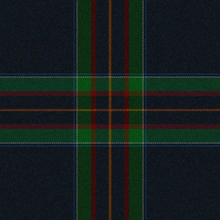
The RCMP has since 1998 had its own distinctive tartan. The creation of the tartan was the result of a committee created in the early 1990s to create a tartan by its 125th anniversary. Upon approval from commissioner Phillip Murray, the tartan was registered with the Scottish Tartans Society and presented to the agency by Anne the Princess Royal during her royal visit to Canada in 1998. The tartan appeared for the first time by a RCMP pipe band at the Royal Nova Scotia International Tattoo in July and August 1998.[132]
Controversies and criticism
American historian Andrew Graybill has argued that the Mounted Police historically resembled the Texas Rangers in many ways. He argues that each protected the established order by confining and removing Indians, by tightly controlling the mixed blood peoples (the African Americans in Texas and the Métis in Canada), assisted the large-scale ranchers against the small-scale ranchers and farmers who fenced the land, and broke the power of labour unions that tried to organize the workers of industrial corporations.[133]
The RCMP have been involved in training and logistically supporting the Haitian National Police since 1994, a controversial matter in Canada considering allegations of widespread human rights violations on the part of the HNP. Some Canadian activist groups have called for an end to the RCMP training.[134] The RCMP has also provided training overseas in Iraq and other peace-keeping missions.
In October 2016, the RCMP issued an apology for harassment, discrimination, and sexual abuse of female officers and civilian members. Additionally they set aside a $100 million fund to compensate these victims. Over 20,000 current and past female employees that were employed after 1974 are eligible.[135]
In 2019, The Guardian revealed that RCMP commanders had advocated the use of “lethal overwatch”—i.e., officers equipped with firearms—while clearing protesters to grant TC Energy access to the lands of the Wet’suwet’en First Nation in order to construct the Coastal GasLink Pipeline.[136]
Chief Allan Adam of the Athabasca Chipewyan First Nation was arrested by two RCMP officers on March 10, 2020 in Fort McMurray, Alberta.[137][138] After several minutes of Chief Adam yelling and posturing at officers, the officers tackled him and punched him in the head whilst struggling with him on the ground. Chief Adam was later charged with resisting arrest and assaulting a peace officer, but the charges were subsequently dropped.[139]
After watching the video of the arrest, Prime Minister Justin Trudeau said, "We have all now seen the shocking video of Chief Adam's arrest and we must get to the bottom of this".[140][137][141] Following the revelation of Chief Adam's arrest—as well as several other recent instances in which RCMP officers had assaulted or killed Indigenous people[142]—RCMP Commissioner Brenda Lucki stated, after initially demurring on the question, that systemic racism exists in the RCMP: "I do know that systemic racism is part of every institution, the RCMP included," she said.[143] One day earlier, Prime Minister Trudeau had also stated that "[s]ystemic racism is an issue right across the country, in all our institutions, including in all our police forces, including in the RCMP."[144]
See also
- Civilian Review and Complaints Commission for the Royal Canadian Mounted Police, the civilian complaints review body
- Courage in Red, a 13-part documentary about the RCMP
- Emergency Response Team (RCMP)
- List of Canadian organizations with royal patronage
- RCMP Technical Security Branch
References
- "RCMP heraldic badge". Public Register of Arms, Flags and Badges of Canada. Office of the Secretary to the Governor General. Retrieved December 17, 2018.
- "Corps ensign of the RCMP". Public Register of Arms, Flags and Badges of Canada. Office of the Secretary to the Governor General. Retrieved December 17, 2018.
- Government of Canada, Royal Canadian Mounted Police (April 19, 2018). "Tipstaff | Royal Canadian Mounted Police". www.rcmp-grc.gc.ca. Retrieved April 27, 2019.
- "History of the RCMP". Royal Canadian Mounted Police. Retrieved April 14, 2016.
- "Auxiliary Constable Program". Royal Canadian Mounted Police. Archived from the original on May 8, 2016. Retrieved May 5, 2016.
- "New RCMP National Headquarters Building: The M.J. Nadon Government of Canada Building". Royal Canadian Mounted Police. October 5, 2011. Archived from the original on April 8, 2016. Retrieved April 11, 2016.
- "Organizational structure". www.rcmp-grc.gc.ca. April 1, 2019. Archived from the original on February 28, 2009. Retrieved April 1, 2019.
- "Find a detachment". Royal Canadian Mounted Police. May 6, 2016. Retrieved May 7, 2016.
- "Canadian Civil Aircraft Register: Quick Search Result for Royal Canadian Mounted Police". Transport Canada. Retrieved June 18, 2017.
- "About the RCMP". Royal Canadian Mounted Police. April 26, 2016. Archived from the original on July 27, 2017. Retrieved May 7, 2016.
- Royal Canadian Mounted Police Act, RSC 1985, c R-10, s 11.1.
- "Inquiry Into Certain Activities of the Royal Canadian Mounted Police, Royal Commission of," Canadian Encyclopedia. Retrieved August 26, 2007.
- p.52 Sendzikas, Aldona Stanley Barracks: Toronto's Military Legacy Dundurn Press Ltd., 01/01/2011
- Hewitt, Steve. "Policing the Promised Land: The RCMP and Negative Nation-building in Alberta and Saskatchewan in the Interwar Period", The Prairie West as Promised Land ed. R. Douglas Francis and Chris Kitzan (Calgary: University of Calgary Press, 2007), 318-320.
- Hewitt, 322
- McIntosh, Dave. The Collectors: A History of Canadian Customs and Excise (Published by NC Press in association with Revenue Canada, Customs and Excise, 1984)
- Kelly, Nora and William. The Royal Canadian Mounted Police - A Century of History 1873-1973. (Edmonton, Hurtig Publishers. 1973) pp 199-200.
- Reg Whitaker, "Left-Wing Dissent and the State: Canada in the Cold War Era." In C. E. S. Franks, Dissent and the State, Toronto: Oxford University Press, 1988, 195. ISBN 0-19-540742-3
- Canada: Royal Canadian Mounted Police (RCMP) Archived February 24, 2018, at the Wayback Machine, Interpol
- The Royal Collection. "e-Gallery > Exhibitions > Queen & Commonwealth > Gifts > Badge of the Royal Canadian Mounted Police". Queen's Printer. Archived from the original on June 8, 2011. Retrieved July 26, 2009.
- Shore, Jacques; Crane, Brian; Wilson, John D. (2017). "Interjurisdictional Information Sharing and National Security: A Constitutional and Legislative Analysis". McGill Law Journal. 62:1: 207–239 – via CanLII.
- PA1 John Masson, "Territorial Teamwork," Coast Guard Magazine 2/2006, pp. 26–27
- Cheung, Carmen K. (2014). "Oversight and Accountability of Canada's National Security Agencies: A Framework for Discussion". The Canadian Bar Review. 92:1: 19–30. 2014 CanLIIDocs 252 – via CanLII.
- "Canoe.ca News December 25, 2007". Archived from the original on December 26, 2007.
- "RCMP National Division, a renamed A Division, to take on corruption". Maclean's. June 3, 2013. Archived from the original on October 29, 2013. Retrieved October 25, 2013.
- https://web.archive.org/web/20120626092154/http://www.rcmp-grc.gc.ca/gazette/vol70n3/air-eng.htm
- Government of Canada, Royal Canadian Mounted Police (December 17, 2014). "Famous cases, events and people | Royal Canadian Mounted Police". www.rcmp-grc.gc.ca.
- CBC Archived May 20, 2007, at the Wayback Machine
- Gil Aegerter. "Three Canadian Officers Killed in Spray of Gunfire". NBC News.
- Ross, David (March 24, 1988). The Royal Canadian Mounted Police 1873-1987. pp. 21–22. ISBN 0-85045-834-X.
- North-West Mounted Police Uniform - Royal Canadian Mounted Police. Rcmp-grc.gc.ca (2011-08-12). Retrieved on 2014-04-12.
- Ross, David (March 24, 1988). The Royal Canadian Mounted Police 1873–1987. p. 36. ISBN -0-85045-834-X.
- Ross, David (March 24, 1988). The Royal Canadian Mounted Police 1873-1987. p. 26. ISBN 0-85045-834-X.
- "1990: Sikh Mounties permitted to wear turbans". CBC Archives. Retrieved February 3, 2017.
- RCMP Hats Archived November 1, 2013, at the Wayback Machine. Furbearerdefenders.com. Retrieved on 2013-10-30.
- "Badges and Insignia". Royal Canadian Mounted Police. Archived from the original on October 13, 2016. Retrieved February 3, 2017.
- "Canada's 'Sherlock Holmes of Forensic Science'". The Kingston Whig-Standard. Retrieved May 25, 2018.
- The encyclopedia of Saskatchewan. University of Regina. Canadian Plains Research Centre. Regina: University of Regina, Canadian Plains Research Centre. 2005. p. 584. ISBN 0889771758. OCLC 57639332.CS1 maint: others (link)
- "Dr. Frances McGill was Saskatchewan's answer to Sherlock Holmes". Regina Leader-Post. June 19, 2017. Retrieved May 25, 2018.
- Moore, Dene. (2012-08-16) Female Mounties earn right to wear pants and boots with all formal uniforms Archived November 6, 2018, at the Wayback Machine. Vancouversun.com. Retrieved on 2014-04-12.
- "William Elliott sworn in as RCMP commissioner". CBC News. July 16, 2007. Retrieved June 13, 2018.
...the organization's first chief not to have served on a police force.
- Andrew Mayada (December 15, 2007). "RCMP commissioner promises sweeping changes". CanWest News Service. Archived from the original on December 17, 2007. Retrieved July 30, 2008.
Elliott was appointed the first civilian commissioner in the RCMP's history
- "Prime Minister announces new Commissioner Designate of the Royal Canadian Mounted Police". Prime Minister of Canada. March 9, 2018.
- "Royal Canadian Mounted Police". Quebec400.gc.ca. February 8, 2008. Archived from the original on July 16, 2008. Retrieved May 22, 2010.
- Vancouver, The (December 7, 2006). "New commissioner for RCMP must restore faith in the famed force". Canada.com. Archived from the original on August 23, 2012. Retrieved May 22, 2010.
- "PM announces charitable donations on behalf of The Prince of Wales and The Duchess of Cornwall". Archived from the original on April 4, 2013.
- "All The Queen's Horses: fourth RCMP steed crosses Atlantic to join Royal Mews". Archived from the original on September 27, 2012. Retrieved January 3, 2011.
- "Royal Canadian Mounted Police". Archived from the original on October 13, 2007.
- "heraldist1". August 1, 2001. Archived from the original on August 1, 2001.
- Furness, Hannah (May 23, 2012). "Queen guarded by Canadian Mounties today" – via www.telegraph.co.uk.
- "North-West Mounted Police and Battleford memorial: Memorial 47001-047 Battleford, SK". National Inventory of Canadian Military Memorials. Veterans Affairs Canada. Retrieved January 5, 2017.
- "Fact Sheet: International Operations Branch" (PDF). Royal Canadian Mounted Police. Archived from the original (PDF) on December 2, 2010. Retrieved April 28, 2010.
-
"DEA Afghanistan Unit Receives Prestigious Joint Chiefs of Staff Award". KETK NBC. February 8, 2012. Archived from the original on May 15, 2013. Retrieved January 19, 2017.
The ATFC began operations in mid-2009 and is a multi-agency organization led by DEA with the Treasury Department and Department of Defense as co-deputies. Additional personnel staff ATFC from the Department of Defense's CENTCOM, the Department of Homeland Security, and the Internal Revenue Service. In the past, the FBI and RCMP also were members. The ATFC’s purpose is to attack insurgence funding and financing networks by providing threat finance expertise and actionable intelligence to U.S. civilian and military leaders. The RCMP have also participated in United Nations Peacekeeping operations, sending members to participate actively in various U.N. missions from the late 1980s including observer missions in Namibia, policing missions in Haiti and Kosovo, and CIVPOL operations in Croatia, Bosnia-Hercegovina, and Sudan.
- Royal Canadian Mounted Police Act, RSC 1985, c R-10, ss 3–4
- Royal Canadian Mounted Police Act, RSC 1985, c R-10, s 20
- R v White, [1956] SCR 154, 1955 CanLII 48 at 158.
- Royal Canadian Mounted Police Act, RSC 1985, c R-10, s 5
- Government of Canada, Royal Canadian Mounted Police (September 22, 2016). "RCMP executive | Royal Canadian Mounted Police". www.rcmp-grc.gc.ca.
- "RCMP Executive". Archived from the original on September 24, 2015.
- "RCMP Police Dog Service Training Centre". Archived from the original on June 25, 2008.
- National Division – RCMP Archived July 13, 2009, at the Wayback Machine. Rcmp-grc.gc.ca (2013-10-17). Retrieved on 2013-10-30.
- "Newfoundland and Labrador".
- "The RCMP in Quebec".
- "RCMP in Saskatchewan".
- "Northwest Territories".
- "RCMP in Nova Scotia".
- "New Brunswick".
- "RCMP in Alberta".
- "Prince Edward Island".
- "RCMP - Yukon (M Division)". Archived from the original on February 5, 2009.
- "RCMP in Ontario".
- "Nunavut".
- Your Surrey RCMP, Royal Canadian Mounted Police (last modified March 31, 2016).
- Canada's second largest RCMP detachment integrates dispatch with E-Comm Regional communications centre Archived March 9, 2018, at the Wayback Machine (press release), E-Comm (October 2, 2013).
- Renato Gandia, RCMP pays tribute to wives who supported officers posted to smallest detachments Archived August 6, 2016, at the Wayback Machine, Calgary Sun (April 12, 2013).
- B.C.'s single-officer RCMP detachments to be closed, CBC News (September 28, 2012).
- Switched on - Blue Line. Blueline.ca. Retrieved on 2013-10-30.
- Tightened tactics breed dissent in Harper’s security detail. The Globe and Mail (2012-06-23). Retrieved on 2013-10-30.
- Government of Canada, Royal Canadian Mounted Police (November 7, 2013). "RCMP in British Columbia - Reserve Constables". bc.rcmp-grc.gc.ca.
- "Auxiliary Constable Program". Archived from the original on May 8, 2016. Retrieved September 5, 2012.
- "Community Constable Program (Synopsis)".
- "Surrey RCMP's Community Safety Officer program chopped". Archived from the original on September 7, 2014.
- "Community Constables".
- "Community-level knowledge sought in new RCMP program".
- "Community constables link citizens and police". Thompson Citizen.
- "RCMP Reserve Program". Rcmpvetsnb.ca. January 1, 1995. Archived from the original on June 5, 2009. Retrieved May 22, 2010.
- RCMP Reserve Constables in B.C.
- "Retired Mounties back in saddle".
- "Telecommunications Operators". rcmp-grc.gc.ca. July 30, 2010. Retrieved September 1, 2010.
- "Royal Canadian Mounted Police (RCMP¨) / Royal Canadian Mounted Police (RCMP) / Gendarmerie royale du Canada (GRC)".
- Government of Canada, Royal Canadian Mounted Police (April 1, 2019). "Organizational Structure". www.rcmp-grc.gc.ca. Archived from the original on February 28, 2009. Retrieved May 17, 2019.
- Government of Canada, Royal Canadian Mounted Police (September 14, 2012). "Regular Member - Annual Rates of Pay | Royal Canadian Mounted Police". www.rcmp-grc.gc.ca. Retrieved July 17, 2019.
- http://www.rcmp-grc.gc.ca/en/rcmp-executive
- http://www.rcmp-grc.gc.ca/en/nb/commanding-officer
- p.38 Ross, David & May Robin The Royal Canadian Mounted Police (1873-1987) 1988 Osprey Publishing.
- pp.38-39 Ross, David & May, Robin The Royal Canadian Mounted Police (1873-1987) 1988 Osprey Publishing.
- pp.38-39 Ross, David & May, Robin The Royal Canadian Mounted Police (1873-1987) 1988 Osprey Publishing
- "Land Transport". Rcmp-grc.gc.ca. November 14, 2006. Archived from the original on June 20, 2010. Retrieved May 22, 2010.
- "Marine Services". Rcmp-grc.gc.ca. Archived from the original on June 22, 2010. Retrieved May 22, 2010.
- "Airbus delivers Canada's first H145 to the Royal Canadian Mounted Police". Airbus (Press release). December 19, 2018. Retrieved June 26, 2019.
- "RCMP Adopts C8 Carbine - Soldier Systems Daily".
- Global News Canada Under Fire: The Carbine (March 26, 2015)
- "EXCLUSIVE: All RCMP cadets now receiving carbine and active shooter training | Globalnews.ca". globalnews.ca. June 15, 2015.
- CTV News Hundreds of Faulty RCMP Tasers Destroyed or Pulled (Sunday, April 18, 2010)
- Leersum, Richard Van (January 1, 2014). "THE GUNS THAT WON THE WEST: THE FIREARMS OF THE N.W.M.P."
- Petzal, David E. and Bourjaily, Phil, with Fenson, Brad. The Total Gun Manual (Canadian edition) (San Francisco: WeldonOwen, 2014) Note 44.
- Petzal and Bourjaily with Fenson. The Total Gun Manual (Canadian edition), Note 44
- Petzal and Bourjaily with Fenson, The Total Gun Manual (Canadian edition), Note 45
- "The .455 Colt New Service and the RCMP". Guns and Ammo. December 6, 2016.
- Petzal and Bourjaily, Phil, with Fenson. The Total Gun Manual (Canadian edition), Note 44
- Phillips, Roger F., & Klancher, Donald J. Arms & [sic] Accoutrements of the Mounted Police 1873-1973 (Bloomfield, ON: Museum Restoration Service, 1982), p.24.
- Petzal and Bourjaily with Fenson. The Total Gun Manual (Canadian edition), Note 45
- "Royal Canadian Mounted Police - Badges and Insignia". Rcmp-grc.gc.ca. February 16, 2005. Archived from the original on July 6, 2010. Retrieved May 22, 2010.
- Force's legacy endures, Toronto Star, March 5, 2005
- "The Royal Canadian Mounted Police presents the 30th anniversary of the Canadian Sunset Ceremonies, June 27–30". CNW Group Ltd. June 26, 2019. Retrieved December 6, 2019.
- "RCMP Musical Ride Sunset Ceremonies". Ottawa Tourism and Convention Authority. Retrieved December 6, 2019.
- "RCMP's Canadian Sunset Ceremonies". todoCanada.ca. Retrieved December 6, 2019.
- "RCMP Heritage Centre - Sunset Retreat Ceremonies". rcmphc.com.
- Barr, William Red Serge and Polar Bear Pants" The Biography of Harry Stallworthy, RCMP University of Alberta Press 2004
- "Newfoundland music books food videos images arts crafts". Archived from the original on September 18, 2012. Retrieved October 25, 2012.
- Farnsworth, Clyde H. (February 4, 1995). "For the Mounties, Justice Is Now a Licensing Fee—New York Times". New York Times. Retrieved May 22, 2010.
- Royal Canadian Mounted Police, "", Retrieved July 28, 2011
- CBC Digital Archives "", Retrieved July 28, 2011
- "History". RCMP Band. April 26, 2014.
- "The Royal Canadian Mounted Police Band". Altissimo!.
- Luscombe, Stephen. "Royal Canadian Mounted Police". www.britishempire.co.uk.
- "ONTARIO - Ottawa - Miscellaneous Obituaries - 130". canadianobits.com.
- "RCMP Community Bands of Pipes and Drums". RCMP. Archived from the original on August 27, 2017. Retrieved December 7, 2019.
- "Band Information: A Community Partnership". RCMP Regina Pipes and Drums. Retrieved December 7, 2019.
- "History — "E" Division". RCMP "E" Division Pipe Band (British Columbia). Retrieved December 7, 2019.
- "Pipes, Drums and Dancers: Nova Scotia". Retrieved December 7, 2019.
- "Tartan". Royal Canadian Mounted Police. Retrieved December 7, 2019.
- Andrew R. Graybill, Policing the Great Plains: Rangers, Mounties, and the North American Frontier, 1875-1910 (University of Nebraska Press, 2007) excerpt and text search
- RCMP Website and "Haiti Support Hits the Streets"
- Harris, Kathleen. "RCMP could pay up to $100M to female employees who were sexually harassed, abused". CBC News. Retrieved October 6, 2016.
- Parrish, Jaskiran Dhillon Will (December 20, 2019). "Exclusive: Canada police prepared to shoot Indigenous activists, documents show". The Guardian. ISSN 0261-3077. Retrieved December 22, 2019.
- Tunney, Catharine (June 12, 2020). "Trudeau has 'serious questions' after watching video of Chief Adam's arrest". CBC News. Retrieved June 13, 2020.
- Porter, Catherine; Bilefsky, Dan (June 13, 2020). "Video of Arrest of Indigenous Leader Shocks Canada". The New York Times. Retrieved June 13, 2020.
- The Canadian Press (June 24, 2020). "Charges dropped against First Nations Chief Allan Adam in violent arrest". CBC News. Retrieved June 24, 2020.
- Cecco, Leyland (June 12, 2020). "First Nations chief shown being punched by Canadian police in video". The Guardian. ISSN 0261-3077. Retrieved June 12, 2020.
- "Full dashcam video of Chief Allan Adam's arrest". CBC News. June 11, 2020.
- "Chantel Moore's family calls for justice, public inquiry during healing walk". CBC News. June 13, 2020. Retrieved June 13, 2020.
- Tasker, John Paul (June 12, 2020). "Systemic racism exists in the RCMP, Commissioner Brenda Lucki says". CBC News. Retrieved June 13, 2020.
- Tunney, Catharine (June 11, 2020). "Systemic racism exists in RCMP, Trudeau argues — after commissioner says she's 'struggling' with the term". CBC News. Retrieved June 13, 2020.
External links
- Official website

- Royal Canadian Mounted Police Reports 1929-1948 at Dartmouth College Library